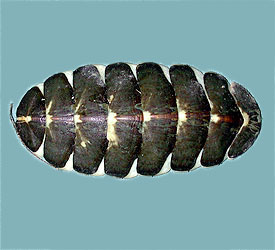(7-0-0-0-0-0-0-0-0-0-0-0-0-0-0)
Ref. Abbott & Dance, 1982 p 284
Amer. Fish. Soc., 1988 p 8,148
Emerson & Jacobson, 1976 p 461
Kaas & Van Belle, 1980
Keen, 1971 p 19,861
Keen & Coan, 1974 p 147
Lindner, 1977 p 16
Simon & Schuster, 1979 p 467
Wagner & Abbott, 1977
Syn. Amphineura in part
Crepipoda A. Goldfuss, 1820
Loricata C. F. Schumacher, 1817
Placophora
Ref. Abbott, 1974 p 392
H.M.D.de Blainville, 1816
Vaught, 1989 p 2
Some taxonomists refer to Class Amphineura with Polyplacophora being a subclass.
This index recognizes Polyplacophora as a separate class. References for Amphineura
are: Keen, 1971 p 19, 859 and Keen & Coan, 1974 p 148. Formerly named classes
Crepipoda, Loricata and Placophora are generally recognized today as Polyplacophora.

